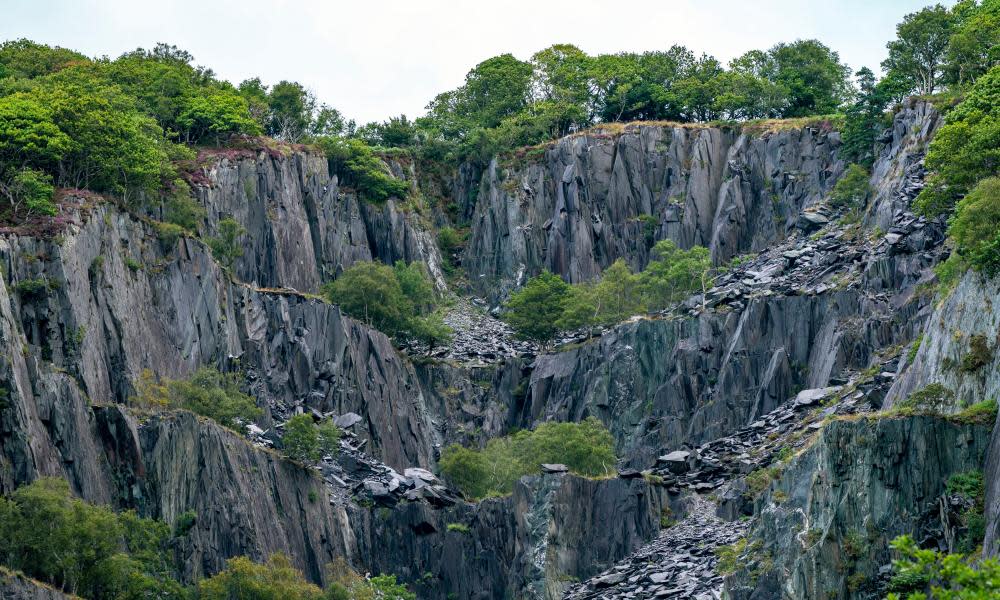Welsh slate landscape becomes UK’s newest world heritage site

The slate landscape of north-west Wales, said to have “roofed the 19th century world” as its quarries exported slate across the globe, has become the UK’s newest Unesco world heritage site.
The landscape surrounding Snowdonia in the county of Gwynedd was awarded the prestigious global status – already enjoyed by sites such as the Great Wall of China, Machu Picchu in Peru, and the Grand Canyon in the US – by the World Heritage Committee meeting in China.
It becomes the UK’s 32nd world heritage site after Liverpool was stripped of its status recently over developments, including the planned new Everton FC stadium, that were said to have resulted in a “serious deterioration” of the historic waterfront site, a decision described by the city’s mayor as “incomprehensible”.
The Welsh slate landscape was announced by the UK government as its nomination for Unesco status in 2018, with Boris Johnson describing it as “an area of remarkable uniqueness and breathtaking beauty”.
The area served international demand for Welsh slate between 1780 and 1940, with Gwynedd also home to major developments in quarrying and stone processing. Though slate had been quarried in north Wales for more than 1,800 years, demand surged during the industrial revolution, with cities growing across the UK, and slate required for roofing.
By the late 19th century, the industry – said to be the only major industry in Britain conducted in a language other than English – was employing more than 17,000 people and producing almost 500,000 tonnes of slate a year, providing around a third of all roofing slate used in the world at the time.
The industry had a huge impact on global architecture with Welsh slate used on a number of buildings, terraces and palaces across the globe including Westminster Hall in London’s Houses of Parliament, the Royal Exhibition Building in Melbourne, Australia, and Copenhagen city hall in Denmark. In 1830, half the buildings in New York had roofs made of Welsh slate.
Centuries of mining in the area transformed the landscape on a monumental scale with the Unesco inscription reflecting the important role this region played in “roofing the 19th century world”.
The successful bid, which was 15 years in making, means Wales now boasts four world heritage sites, with its addition to Pontcysyllte Aqueduct, Blaenavon industrial landscape, and the castles and town walls of King Edward in Gwynedd.
The Welsh first minister, Mark Drakeford, said: “Today’s announcement recognises the significant contribution this part of north Wales has made to the cultural and industrial heritage not only of Wales, but of the wider world. Welsh slate can be found all over the world.
“The quarrying and mining of slate has left a unique legacy in Gwynedd, which the communities are rightly proud of. This worldwide recognition today by Unesco will help preserve that legacy and history in those communities for generations to come and help them with future regeneration.
The UK government’s heritage minister, Caroline Dinenage, said: “Unesco world heritage status is a huge achievement and testament to the importance this region played in the industrial revolution and Wales’ slate mining heritage. I welcome the prospect of increased investment, jobs and a better understanding of this stunning part of the UK.”
Christopher Catling, the secretary of the Royal Commission on the Ancient and Historical Monuments of Wales, whose staff helped to compile the nomination document, said: “Human muscle and ingenuity have left us with a remarkable landscape combining natural and man-made features that are fully worthy of being included in the top tier of all heritage sites in the world.
“Here you can see the evidence for the entire slate production process, from hillside quarry and cavernous underground mines to the engine houses, wheelhouses and mills powered by ingenious water systems needed to work the slate; the inclines and aerial ropeways used to carry raw and worked slate from remote hills to tramways, and the narrow-gauge railways capable of negotiating mountainous terrain carrying slate to the harbours at Port Penrhyn and Porthmadog for shipment to all parts of the world.”
The City of Bath – originally inscribed on the world heritage list in 1987 – has also been awarded a dual designation as part of the great spas of Europe.

 Yahoo News
Yahoo News 